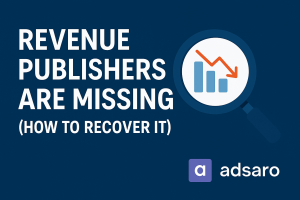As a publisher, you might be creating great content and driving traffic, but you could still be leaving money on the table. Maximizing your revenue goes beyond just increasing page views -it’s about optimizing your monetization strategies. If you want to truly succeed as a revenue publishers, it’s crucial to tap into all possible revenue streams.
In this blog, we’ll uncover the revenue gaps most publishers overlook and provide practical strategies to recover that lost income. By applying these insights, you can transform your approach and become a highly efficient revenue publishers who maximizes every opportunity.
Why Publishers Miss Out on Revenue
Many publishers miss out on revenue because they fail to fully optimize their ad placements, rely on a single demand source, or overlook mobile performance and user experience issues. Without proper testing and strategy, even high-traffic sites can underperform in monetization.
To avoid these common pitfalls, a revenue publisher must take a proactive approach-implementing header bidding, improving ad viewability, and continuously analyzing performance data. A true revenue publisher focuses not just on growing traffic but on extracting the maximum value from every visitor.
Low Ad Viewability
Ad viewability is crucial to your earnings. If your ads are placed too far down on the page, or if users scroll past them too quickly, advertisers won’t be willing to pay top dollar for those impressions. Ad viewability scores are now a central factor in how advertisers value your site and bid for your ad inventory.
When users can’t see your ads, it’s as though they aren’t there at all. The problem is even worse if users interact with your content in ways that bypass your ads-like using ad blockers or browsing mobile-first content. These factors all lead to lower ad revenue.
No Header Bidding
If you’re only using one ad network (such as AdSense) to serve ads on your site, you’re probably missing out on competitive pricing for your ad space. Header bidding enables multiple demand partners to place bids for your inventory in real time. Without header bidding, your ad space is sold off to a single network, resulting in lower CPMs (cost per thousand impressions) and missed opportunities.
By implementing header bidding, you open the door to higher bids and increased competition for your ad space. This leads to better monetization, especially as more demand sources vie for your inventory.
Cumulative Layout Shift (CLS) Issues
A smooth user experience is essential, but ads that disrupt this flow can result in poor user engagement and lower ad revenue. When ads move content around unexpectedly (a phenomenon known as “Cumulative Layout Shift” or CLS), users are less likely to engage with the content, and ultimately, less likely to click on ads.
Websites with poor CLS performance suffer from lower user trust and ranking penalties from Google, making it harder to generate revenue from advertisers who seek high-quality user engagement.
Ignoring Mobile Optimization
With mobile traffic dominating the web, it’s critical that your ad units and layout are optimized for mobile users. Many publishers overlook this aspect, assuming that desktop optimization is enough. However, if your ads aren’t optimized for mobile devices, you’re losing revenue from a large portion of your audience.
Responsive ad units and mobile-optimized layouts are essential for providing a seamless experience for your mobile users. If your website loads slowly or your ads don’t display properly on mobile devices, you’re missing out on a significant revenue stream.
Lack of A/B Testing
One of the most important yet overlooked strategies for improving ad revenue is A/B testing. If you’re not experimenting with different ad placements, formats, or even different ad networks, you’re not fully optimizing your monetization strategy.
Testing can reveal which ad formats perform best, where to place ads for maximum visibility, and what types of content generate the most engagement. Without A/B testing, you may be missing out on revenue opportunities that could significantly improve your bottom line.
The Numbers Don’t Lie: Optimizing Your Setup Pays Off
Data consistently shows that optimizing your ad strategy and layout can have a significant impact on your revenue. For instance, publishers who adopt header bidding can see CPM increases of up to 40%. Websites with high ad viewability scores attract premium advertisers and higher bids, which directly correlates with higher revenue.
Ad refresh strategies that use user behavior, rather than relying on fixed timers, can increase revenue by 15-25%. These simple optimizations can dramatically improve your earning potential without the need to increase your traffic.
How to Recover Lost Revenue
To fix the revenue leaks and improve your monetization, here are some actionable steps that you can take:
Improve Ad Viewability
Position Ads Strategically: Place ads closer to the content where users are most likely to see them, such as in the header or directly within articles.
Use Sticky Ads: Sticky ad units that remain visible as users scroll can boost exposure and engagement.
Lazy Load Ads: Implement lazy loading to ensure ads are loaded only when visible to the user, improving both site speed and viewability.
Implement Header Bidding
Adopt Prebid: Prebid is the most popular open-source header bidding solution that lets you easily integrate multiple demand sources.
Evaluate Your Demand Sources: Regularly monitor and optimize the SSPs (Supply-Side Platforms) you’re using to ensure you’re getting the best bids for your ad space.
Ensure Seamless Integration: Make sure your header bidding setup doesn’t slow down your site’s loading time. Test for performance and optimize accordingly.
Fix CLS Issues
Reserve Space for Ads: Ensure that your ad units have dedicated space on your pages so that they don’t push the content around unexpectedly.
Use Non-Intrusive Ad Formats: Avoid pop-ups, interstitials, or ads that load unpredictably and disrupt the user experience.
Test and Monitor CLS: Regularly monitor CLS metrics using tools like Google PageSpeed Insights and adjust your ad layout as needed.
Optimize for Mobile
Responsive Ads: Use ad units that automatically adjust based on the user’s device and screen size.
Speed Optimization: Ensure your site loads quickly on mobile devices by optimizing images, scripts, and server performance.
Mobile-Friendly Ad Formats: Use native ads or in-feed ads, which perform better on mobile devices.
A/B Test Everything
Ad Placement Tests: Experiment with different ad placements to see which locations generate the highest revenue.
Ad Format Tests: Test different ad formats, such as banners, native ads, and video, to determine which performs best with your audience.
Network and Partner Tests: Try different ad networks to find the best-paying options for your site.
Let Technology Help Maximize Your Revenue
Staying on top of the latest ad tech can be a full-time job. Fortunately, there are platforms designed to handle much of the optimization for you. From automatic header bidding integrations to real-time performance tracking, these platforms make it easier for publishers to optimize revenue without doing all the heavy lifting.
If you’re serious about recovering lost revenue, it’s time to explore a platform that can streamline your monetization efforts, ensuring you get the best results without the constant manual effort.
Final Thoughts: Maximizing Your Revenue Potential
Monetization is not a one-time setup-it’s an ongoing process that requires strategy, experimentation, and the right partners. If you’re not seeing the results you expect, it might be time to revisit your setup and see where improvements can be made.
Platforms like Google Ad Manager, Prebid.js, and Amazon Publisher Services provide powerful tools for better yield management and real-time bidding. Leveraging these technologies can help you scale smarter and earn more from your existing traffic.
To thrive as a revenue publishers, you must stay ahead of trends, invest in optimization, and embrace tools that give you better control and insight. Don’t let poor setup or outdated strategies hold you back-evolve, experiment, and optimize. That’s the mindset of a successful revenue publisher.s a top revenue publishers.








Leave a Reply